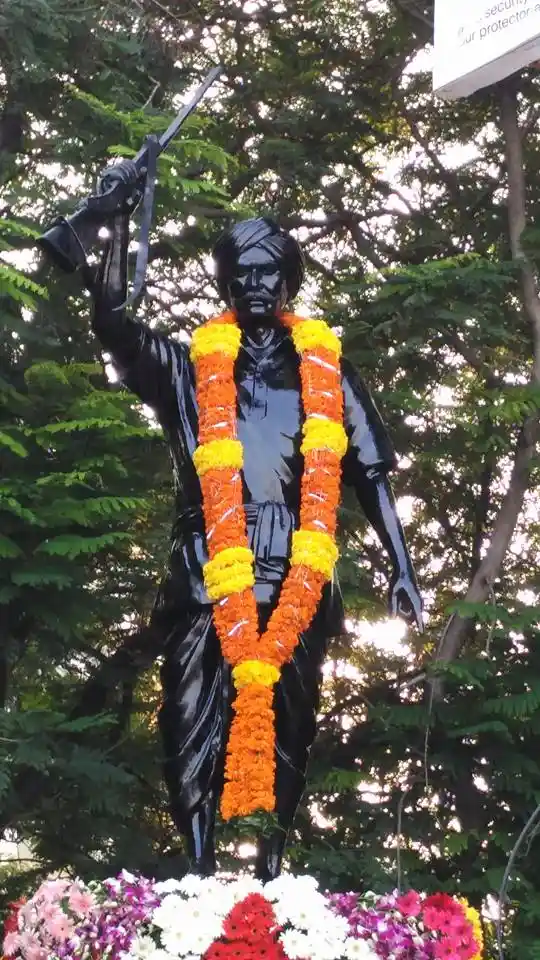Jal Jungle Zameen: The legend of Komaram Bheem
S.S. Rajamouli’s blockbuster hit, RRR is based on the life of two great tribal leaders of India, Alluri Sitaram Raju, and Komaram Bheem. While the movie portrays a fictional account of their lives, their real-life was just as fascinating as their reel life. And this is the story of Komaram Bheem and his struggle against injustice and oppression.

He is worshipped today as Bheemal Pen by the Gond community; Image source: Wikimedia commons
This story begins in the 1900s, among the Gond tribe living in the Nizamate of Hyderabad. In this tribe was born Komaram Bheem, an ordinary boy who in time would attain a godlike status in his community.
Komaram Bheem spent most of his childhood and adolescence in the densely forested area surrounding the Deccan kingdoms of Chanda and Ballalpur, cut off from the larger world. His family had to constantly keep moving because the Gondi tribe was constantly under exploitation by the zamindars and businessmen. Furthermore, the forest police, aka Jangalaat police extorted them both financially and physically. Thus Bheem spent most of his childhood relocating from place to place, never settling in.
As mining activities increased during the 1900s, it began to threaten the subsistence of the Gondi tribe. Their right over forest land was compromised with an expanding state and growing zamindars taking control of the larger territory. This led to protests and retaliation by the Gondi people against this forced eviction of them from their traditional lands. And in one such incident of violence, a forest official killed Bheem’s father.
After his father’s death, Bheem along with his family moved again and finally settled in the land of zamindar Laxman Rao. The turn of events that followed would set Bheem on a path at the end of which he would emerge a hero, a leader, and a god.
Just like most zamindars, Laxman Rao sought to exploit the Gondi tribe for his gains. He sent Siddiquesab, a senior state official to confiscate the crops Bheem and his family had harvested. An argument broke out and Bheem killed Siddiquesab. He ran away to the city of Chanda to avoid being arrested.
The strange city away from the forest was alien to Bheem, however, he was lucky to find a friend in Vitobha, a local publisher who printed and distributed magazines of dissent against the state, both Nizamate and the Colonial power.
Vitobha was sympathetic to Bheem’s cause and provided him with refuge. Living with Vitobha, Bheem also learned to speak and read English, Hindi and Urdu. However, when Vitobha was arrested, Bheem was forced to run again. This time with the help of a friend in railways, Bheem ran away to Assam and started working on a tea plantation. He was far away from his home, and yet the sting of oppression remained the same.
During these day colonial officials and plantation owners in Assam exploited the labourers just as Bheem and his family were exploited back in the forests of Chanda. He joined a labour union to protest against this oppression. He was arrested for it but escaped from jail in just 4 days.
Bheem wanted to go home now. He remembered the stories of Ramji Gond that he had heard in his childhood. He recalled how Ramji Gond took up arms against the British soldiers to protect his Gond kingdom. Inspired by his childhood hero, Bheem decided that he needed to start his struggle for the rights of the Adivasi. His first choice however wasn’t violence.
He tried to directly approach the Nizam and present the Adivasis' troubles to him, but his efforts got no response.
The apathy of those in the higher position could only be shaken by the blows of violence. Bheem decided that an armed rebellion was his only option and began his preparations.
He formed a secret association with the Communist Party of India and started organizing the tribal population. A council of 12 tribal leaders was called and they decided to form a standing guerilla army to begin their armed rebellion against the Nizamate and the Colonial power. An uprising started among the Gond tribes, who began mobilizing and attacking the landlords.
Fearful of the fire of rebellion spreading, the same Nizam who earlier hadn’t even acknowledged Bheem’s appeal now recognised him as the leader of the rebellion and sent the collector of Asifabad to negotiate with him, even offering land grants to the Gonds. Bheem however wasn’t bought off and instead said that the Gond wanted justice. He demanded the eviction of zamindars and forest officials from the traditional Gondi land.
The negotiation failed and Bheem’s struggle against the state continued for almost two decades. He directly commanded 300 men and gave the famous slogan of Jal, Jungle, Zameen (Water, Jungle, Land) to remind his comrades to not compromise on anything lesser than that.
After eluding the state and in a way, death for nearly two decades, his fate caught up to him in 1940 when he was killed in an encounter with the police. However, the movement he started didn’t die with him and instead went on to become a part of the larger Telangana rebellion against the Nizam. His slogan of Jal, Jungle, Zameen which encapsulates the spirit of rebellion against encroachment and exploitation became the war-cry of Adivasi communities.
His community deified him. For them, he had now become Bheemal Pen, a god among mortals who inspired them to fight for their rights. They worship him, and every year they commemorate his death anniversary.
Komaram Bheem was a man who spent his life fighting against injustice, and in the duration of his fight became a legend among his people. However, his story shouldn’t be confined to a particular community, for it is a story of perseverance and an uphill battle against injustice.


